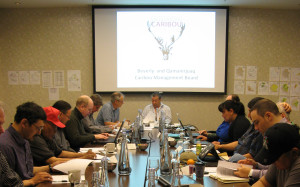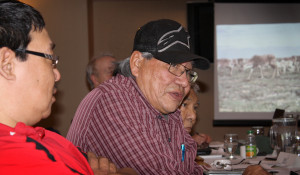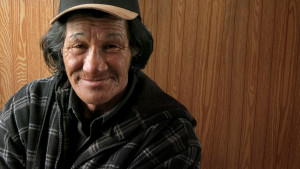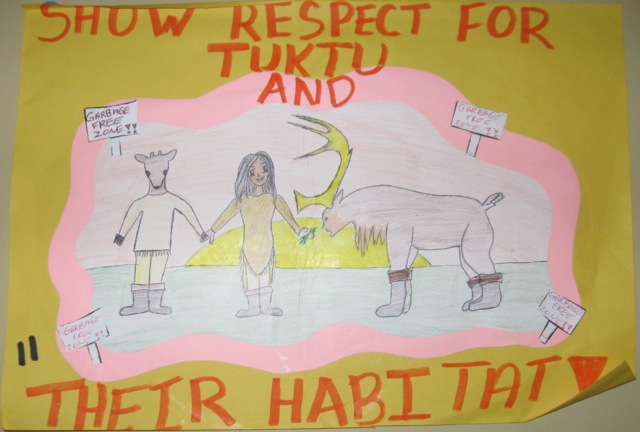Success Via Cooperation
[one_half]
Board Provides Valuable Direction
The BQCMB was created to protect the Beverly and Qamanirjuaq barren-ground caribou herds for present and future generations. Its strength comes from working cooperatively with various Aboriginal groups, communities and governments, and the Board provides advice and knowledge to many organizations, primarily governments and communities.
When members come together to meet twice a year, travelling from Manitoba, Saskatchewan, the Northwest Territories and Nunavut, they spend much of their time discussing issues that relate to the conservation of the Beverly and Qamanirjuaq caribou herds.
[/one_half]
[one_half_last]

[/one_half_last]
Aboriginal Groups and Governments Working Cooperatively
[one_half]

[callout1]BQCMB’s decisions come about by consensus, where all board members agree on a recommendation and feel comfortable with it.[/callout1]
[/one_half]
[one_half_last] Of all the strides made throughout the board’s history, none is more important than the improved level of trust and respect among different aboriginal and government groups that these meetings have fostered. Before, relations were uneasy as different cultures and knowledge systems collided. But both sides have made tremendous efforts to find common ground, in order to conserve caribou for the use of future generations.
Aboriginal people demonstrated remarkable courage in abandoning past positions, and government board members have learned to be patient. They have learned to understand that aboriginal people avoid snap decisions and generally prefer decision by consensus. Aboriginal people prefer thorough discussion that includes elders in each community.
As it happens, most of the BQCMB’s decisions come about by consensus, where all board members agree on a recommendation and feel comfortable with it. Often board members from caribou-range communities return home and talk with local elders and others first before bringing those viewpoints back to the next BQCMB meeting for the final decision.
[/one_half_last]
Achievements
[one_half]
Much of the board’s energy is also devoted to telling others about caribou conservation. Board members attend various workshops, conferences, and meetings across Canada to give presentations to communities and organizations andexplain the BQCMB’s work.
Hunters who are board members report back to their communities, and board members employed by government departments advise their colleagues about BQCMB positions on different matters.
Conserving the Beverly and Qamanirjuaq herds is also the board’s reason for being, but educating the public about caribou conservation is a major part of what the BQCMB does. Since 1982, this work has manifested itself in different, tangible ways.
[/one_half]
[one_half_last]

[/one_half_last]
[heading_horizontal type=”h6″ margin_top=”20px” margin_bottom=”20px”]
Environmental Review of the Proposed Kiggavik Uranium Mine And Mill Project
[/heading_horizontal]
In 2010, the BQCMB received $90,000 in federal funding to participate in the environmental review of the proposed Kiggavik uranium mine and mill project, a $1.5-billion project 80 kilometres west of Baker Lake, Nunavut that – if approved – would become Nunavut’s first uranium mine.
The proposed Kiggavik uranium project, majority-owned by AREVA Resources Canada Inc., would create four open pit mines, one underground mine, a mill, a new transportation network and more.
[callout1]The BQCMB is not against mining or other forms of economic development but believes that it is essential that key important caribou habitats are protected.[/callout1]
The BQCMB has repeatedly said that the precedent-setting project could cause significant imp acts on caribou, habitat and hunting activities. This includes numerous short- and long-term potential impacts and cumulative impacts associated with disturbance, radioactive materials and other environmental contaminants. These would affect not only Inuit in Nunavut but traditional hunters from the Northwest Territories (NWT), Saskatchewan and Manitoba, too.
BQCMB comments and analysis on the proposed Kiggavik project date back to March 2007. More recently, the Board has:
- Outlined concerns and provided recommendations to the Nunavut Impact Review Board (NIRB) for review scoping, EIS guidelines, and the review process – early 2011
- Participated in the NIRB’s EIS guidelines development workshop in Baker Lake – March 2011
- Submitted information requests to the Nunavut Impact Review Board (NIRB) – January, 2012
- Submitted technical comments on the Draft Environmental Impact Statement – April, 2013
- Participated in NIRB technical meetings and presented at a pre-hearing conference – May-June, 2013
- Hosted workshops with Baker Lake and Arviat HTOs – March, 2014
- Met with AREVA in April, 2014
- Participated in Final Hearing (March, 2015)
July 2016 – Federal Ministers accept the NIRB’s recommendation issued in May 2015 that the Kiggavik Project should NOT proceed at this time. Minister’s Decision Re: NIRB Final Hearing Report
[heading_horizontal type=”h6″ margin_top=”20px” margin_bottom=”20px”]2010 Caribou Workshop[/heading_horizontal]
More than 75 elders, hunters, government staff, scientists and others from Saskatchewan, NWT, Nunavut, Manitoba, Alberta, Yukon, British Columbia and Ontario gathered in Saskatoon Feb. 23-25, 2010 to explore ways to protect Beverly and Qamanirjuaq caribou and habitat. The BQCMB Caribou Workshop was organized with the help of numerous sponsors: NWT’s Department of Environment and Natural Resources, Nunavut’s Department of Environment, the Saskatchewan Ministry of Environment, Indian and Northern Affairs Canada (NWT and Nunavut regional offices), Manitoba Conservation, Prince Albert Grand Council, the Athabasca Land Use Office, the Athabasca Denesuline Negotiation Team, the Nunavut Wildlife Management Board, WWF-Canada, AREVA Resources Canada Inc., and Cameco Corp. The populations of most barren-ground caribou herds around the world are declining these days as a result of result of natural and human-caused factors, and NWT government annual reconnaissance surveys conducted on the Beverly traditional calving ground since 2007 have witnessed fewer and fewer animals on transect.
Through a series of small group discussions, participants at the 2010 BQCMB Caribou Workshop concluded that five main factors affect the Beverly and Qamanirjuaq herds today:
- climate change
- loss of habitat due to forest fires on the winter range
- disturbance from human land use activities
- harvesting, and
- predation (especially on the calving grounds). Many ideas were suggested for taking pressure off caribou.
These have been featured in reports published following the Caribou Workshop: a 26-page Overview Report and a 60-page Detailed Report that describes many workshop presentations, gives a more comprehensive account of comments about challenges facing the Beverly and Qamanirjuaq herds, and provides possible solutions.
- [button size=”small” style=”coffee” url=”/pdf/BQCMB_Caribou_Workshop_Overview_Report.pdf” target=”” icon=”fa-file-o” popup=”” title=””]Download[/button] Report: BQCMB Caribou Workshop February 2010 – Overview Report: Challenges Facing the Beverly and Qamanirjuaq Caribou Herds and Some Possible Solutions [2011]
- [button size=”small” style=”coffee” url=”/pdf/BQCMB_Caribou_Workshop_Detailed_Report.pdf” target=”” icon=”fa-file-o” popup=”” title=””]Download[/button] Report: BQCMB Caribou Workshop February 2010 – Detailed Report: Commentary from Workshop Participants about Challenges Facing the Beverly and Qamanirjuaq Caribou Herds and Some Possible Solutions [2011]
- [button size=”small” style=”coffee” url=”/pdf/February_2010_BQCMB_Caribou_Workshop_Summary.pdf” target=”” icon=”fa-file-o” popup=”” title=””]Download[/button] Plain language summary: News from the BQCMB Caribou Workshop, February 23 – 25, 2010 [2010]
[heading_horizontal type=”h6″ margin_top=”20px” margin_bottom=”20px”]Other Accomplishments [/heading_horizontal]
[one_half]
Caribou Economic Valuation Revised Report – 2013 – A 2008 socio-economic evaluation of the Beverly and Qamanirjuaq herds by InterGroup Consultants put the total annual net value of the caribou harvest at more than $20 million. This report was revised in 2013.
20th Anniversary Report: Beverly and Qamanirjuaq Caribou Management Board 1982 – 2002 – the BQCMB passed a milestone in 2002, with two decades of caribou management under its belt, strong relations between jurisdictions with a stake in the caribou range, and loyal, long-serving board members pivotal to the board’s success. This 62-page full-colour report profiles the herds and people of the caribou range, the challenges facing the caribou and their habitat, and the Board’s management efforts to meet these challenges. To download a PDF version of this report, click here.
Protecting Calving Grounds, Post-Calving Areas and Other Important Habitats for Beverly and Qamanirjuaq Caribou: A Position Paper by the Beverly and Qamanirjuaq Caribou Management Board – mineral exploration is rapidly accelerating in northern Canada, a geologically rich and relatively untapped source for minerals ranging from diamonds and gold to platinum, nickel, zinc, uranium and more. Current policies and measures are not adequate to protect the Beverly and Qamanirjuaq herds from human-caused disturbance that has potential to cause significant adverse effects to the caribou and their key habitats across their ranges.
In September 2004, the BQCMB released a position paper that makes five key recommendations to governments and relevant planning and regulatory agencies, among them long-term legislated protection for the herds’ traditional calving grounds and post-calving areas that prohibits activities causing serious or irreversible negative effects to caribou or habitat. Learn more about the BQCMB’s recommendations here (links to PDF file). Or read the plain language summary of the position paper “Protecting Beverly and Qamanirjuaq Caribou for All Time”
- English
- Inuktitut
- Dene
Important Habitats Report, CD-ROM and Data – with mining developments promising to alter the landscape of Canada’s North, the Beverly and Qamanirjuaq Caribou Management Board took steps in 1996 to research and map out the most important habitats of the Beverly and Qamanirjuaq ranges. The result was the report,Protecting Beverly and Qamanirjuaq Caribou and Caribou Range, published in January 1999. A CD-ROM, Protecting Beverly and Qamanirjuaq Caribou and Caribou Range. Part 2: Map Atlas and Documentation, was released in 2000. With 75 maps of the Beverly and Qamanirjuaq caribou range, 30 tables summarizing sources of data, a water- and ice-crossings rating system, and the entire 52-page report, it is an excellent tool for people involved in land use planning, protected areas planning, and impact assessment work on the caribou range.
A separate Data CD has SPANS GIS data and mapping files created for mapping caribou distribution and movements, and supporting documentation. It was created to make this information available to others to use during land use planning, protected areas planning, and impact assessment processes. Copies of the Data CD are on deposit with the Manitoba Conservation Data Centre in Winnipeg, and the Saskatchewan Conservation Data Centre in Regina.
Contact information for data requests is provided on the Map Atlas CD under Part 2: Map Atlas and Documentation – Information about Data Sources.
Established Categories of Priority Use – in 1998, the BQCMB updated its methodology for determining allowable harvest of caribou. The categories are, in descending order of priority:
- Traditional users – domestic use
- Residential users – domestic use
- Traditional users – intersettlement trade
- Local use for commercial purposes
- Outfitting
- traditional users
- non-residents
Man and the Biosphere Acceptable Harvest Practices Study – the BQCMB guided a University of Alaska research team on this initiative gleaning viewpoints of traditional users and wildlife managers on caribou harvesting practices. This was part of a larger project comparing the management systems of Canada’s Beverly and Qamanirjuaq herds with the parallel structure overseeing the United States’ Western Arctic herd.
[/one_half]
[one_half_last]
Barren-Ground Caribou Schools Program – produced between 1983 and 1985, this four-volume kit provided teachers in caribou-range communities with activity books, videos, slides and other resource material that introduced to them the world of caribou management. This was done by talking about caribou both from the perspective of traditional knowledge (from people who have used caribou for generations), and scientific knowledge.
Caribou Schools Competition – an annual event until 1999, the Caribou Schools Competition encouraged schoolchildren living on the caribou range to enter their posters, stories and other creations in a contest that focused on a pivotal aspect of these children’s lives: caribou. Entries were judged by board members, and cash prizes awarded.

Caribou News – the BQCMB was born of the need for improved communication. The board’s independent newspaper, Caribou News, helped to accomplish that by investigating a wide array of issues, reflecting life as it is in the caribou-range communities, and encouraging frank and open discussion from readers. First printed in October 1980, Caribou News endured until June 1996 when funding ran out (once published six times a year, it later dwindled to two issues yearly). It has since been replaced by the smaller Caribou News in Brief.
Fire Management Studies – years of effort, including time spent collecting traditional knowledge to map out priority caribou hunting areas on the range, led to the publication in 1995 of the BQCMB’s Fire Management Technical Report No. 1 along with the shorter summary, Management Report No. 1. Under the direction of chief author and board member Don Thomas, the studies examined the ecological role of fire in the boreal forest and how it relates to caribou – both in good and bad ways. From these reports, governments and firefighting managers in Saskatchewan, Manitoba and the Northwest
Territories learned the board’s recommendations for maintaining precious winter caribou habitat.
Caribou Management Scholarship Fund – in 1988 the BQCMB established a scholarship fund to help university students studying the management and conservation of barren-ground caribou and their habitat. Administered by the Association of Canadian Universities for Northern Studies, the annual award goes up to $1,500 and is open to anyone studying barren-ground caribou in Canada, although preference is given to applicants from a caribou-range community and to those examining the Beverly and Qamanirjuaq herds.
The Beverly and Qamanirjuaq Barren-Ground Caribou – aimed at students as young as Grade 2, this colorful, 20-page illustrated booklet on caribou conservation and the meaning of co-management was printed in separate English, Inuktitut and Dene versions in 1995 and distributed to schools throughout the caribou range. “With 25 years of experience in communicating with northern communities on caribou issues, I know a good product when I see it,” responded one Yukon-based caribou biologist, “and this is certainly the best yet for this purpose.”
Hunters’ Code of Ethics – A “Hunt Wisely” poster was distributed to caribou-range communities in 1998. The Board worked with area hunters to hammer out a hunters’ code of ethics – something of a moral manual for the hunting profession that crosses provincial and territorial borders.
Target Poster and Target Competitions – improved marksmanship leads to fewer caribou being crippled by a careless shot. So in 1990, the BQCMB produced a life-size target poster to improve shooting skills, and a short time later began sponsoring shooting competitions in caribou-range communities that made use of the posters and target-shoot rules. Those competitions are still popular today, and often coincide with community festivals.
The Beverly and Qamanirjuaq Caribou Management Board: A Model of Co-Management – in 1995, the story of the BQCMB was captured in a 22-minute video by Ottawa filmmaker George Mully. The video’s name comes from a tribute to the board issued in a report from a parliamentary standing committee examining co-management in Canada. Using news footage and interviews with board members, the video is an honest confession of the perceived crises that spawned the Board, the past tensions between native people and government employees, and the hard-earned strides made in bringing the two sides closer to understanding.
[/one_half_last]